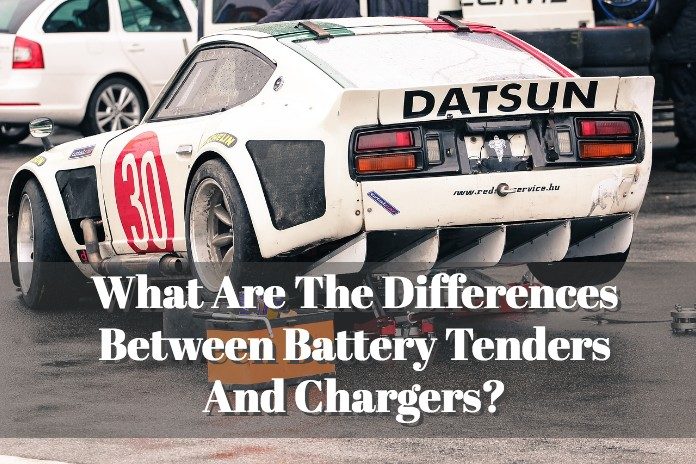
When it comes to cars, no one wishes to have a flat battery. We both know what a flat battery usually feels. The experience can get even worse if it happens in a deserted region. There is no one out there to come to your rescue. It’s for this reason that professionals insist that every driver should have at least a jumper cable, battery charger, or even a reserve battery.
When it comes to recreational vehicles, for example, the situation is different. Remember, these cars can stay up to half a year without being used. It’s at this point that most people are always asking which is better to invest in, between a battery tender and a battery charger.
You will need to know the difference between battery tender and charger to decide which is better among the two. Some of the common differences between the two devices revolve around:
• Both have different wiring/circuitry
• A battery charger requires monitoring while a battery tender doesn’t
• A battery charger charges slowly as opposed to a battery tenders
• A battery tender shuts off once the battery is full while a battery charger has to be removed manually
Battery Tender Vs. Battery Charger
1. Definition
What is a Battery Tender? Often, many drivers find themselves confusing between a battery tender and a charger. The truth is that the two may seem similar, but their properties set them far much apart. Say, for example, a battery tender/maintainer is a device that you plug into an AC output. After the connection, the device charges the battery until it’s full. Once full, the device then shuts automatically and starts providing a constant charge to maintain that current state.
What’s a Battery Charger? A charger, on the other end, does the same work of charging. But once the charging period is over, the device must be pulled out. If the charger isn’t removed, it means that it will continue charging and hence overcharging the battery.
2. Circuitry
When it comes to distinguishing a battery tender from a battery charger, you must take your time to observe the circuitry or wiring. By now, you understand that a battery tender gets designed for a more complex task.
As a result, it’s likely to have an intricate appearance and design to accommodate the extra features. The charger, on the other end, doesn’t have additional features and hence appears to be simple in structure.
3. Use
Wherever you use any of the two devices also brings a difference. Battery tenders are more maintenance chargers. By saying that they are maintenance chargers, it means that they help keep your charger in the same state for a long time.
With a tender charger, for instance, you can have your RV’s battery in the same state of charge for even a year. It’s for this reason that you’re advised to have a tender charger for your recreation boat or even car.
A battery charger in this setting functions the same way as an old battery charger. It only does the charging. If not monitored, it can end up damaging the cell, shortening its lifespan. Battery chargers are, therefore, used mostly on cars that get used regularly.
Therefore, if you want a charger for your daily-use vehicle, you ought to consider a charger. (Here is the list of the best chargers you can take a look at). But, if you’re looking for something to keep your boat, RV, golf cart, or that seasonal car, a battery tender is all that you need.
4. Charging Speed
How long does your car battery charger take to fill up the cell? Most chargers take up to 10 hours or an entire night to get the battery charged. Well, battery chargers usually charge at a constant rate, and this can be slow as compared to battery tenders.
Battery tenders are known for their advanced features. You can easily change the charging speed depending on how quick you want your battery charged.
5. A Battery Tender is Automatic
How does it feel leaving your battery to charge overnight? Often, it’s usually scary, especially when you’re dealing with a charger. One is often scared that the charger may overcharge the battery. As you’re aware, overcharging a battery can damage the plates and even shorten its lifestyle. (This article explains more).
When dealing with a battery tender, you don’t have to worry about cases of overcharging. A battery tender has an automatic feature, and that means that it switches off the flow of charges, once the battery is full. With a battery tender, you don’t have to spend your precious time watching while the battery charges.
6. Price
With the added features, it’s evident that a battery tender comes at a higher cost as compared to the chargers. However, you must have in mind that the size of the device does matter when it comes to pricing. For instance, you can find small battery tenders that are cheap as compared to the large battery chargers.
Pros and Cons of Using Battery Chargers
Pros:
• They are easy to use – as compared to battery tenders, chargers are easy to connect and use as they have fewer features.
• Easily portable – most chargers are usually light in weight. Thus, they are easy to carry around based on where you intend to use them.
• Affordable – although the price of chargers can be high, most of them are much affordable and perfect to start with, as a newbie.
Cons:
• Require to get charged – chargers can only come to your rescue if they have any remaining charge. Without any chargers, the charger can be of any help during an emergency.
Pros and Cons of Using Battery Tenders
Pros:
• Automatic – with the device’s automatic switch-off feature, you won’t have to worry about cases of the battery overcharging. They immediately kill the power flow once the battery reads full.
• They can charge the battery fast – a battery tender can be set to fill up your battery in the fastest time possible because of its automatic shut off system.
Cons:
• They come at a high price as opposed to chargers.
Sources:
1. Pros/Cons of battery tender – VTXOA
2. Pros And Cons Of A Car Battery Charger Vs. Jump Starting A Battery – Zero2Turbo





